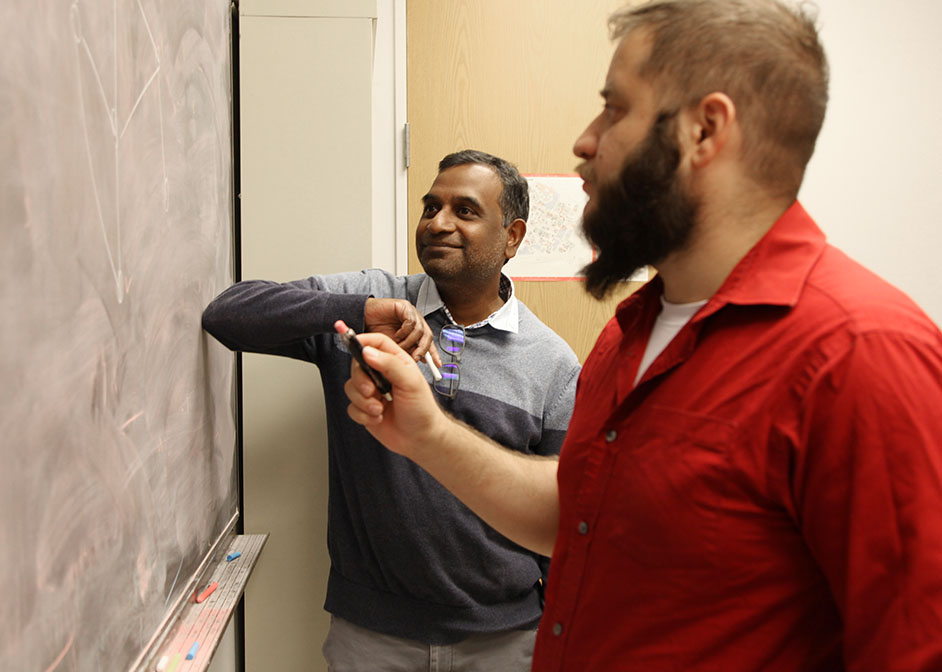NSF-Funded Study Focuses on Employee Productivity While Navigating COVID-19
Computer scientists at the University of Houston partnered with international researchers to identify ways to alternate employee schedules with the goal of restoring productivity levels to pre-pandemic levels. They were able to achieve this through group scheduling and documented their work in the scientific journal, PLOS One.

Gopal Pandurangan, a computer science professor at the UH College of Natural Sciences and Mathematics, co-authored the study with UH computer science Ph.D. student Khalid Hourani and UH engineering undergraduate student Adi Pasic, John Augustine of the Indian Institute of Technology at Madras, and Anisur Rahaman Molla of the Indian Statistical Institute, Kolkata.
Their work, funded by the National Science Foundation, began in the spring of 2020. The study was published in September 2022. What they found was a correlation between rates of COVID-19 virus spread and the number of days worked.
Population Simulation and Group Scheduling
The study, based on a population simulation modeled after a city, looked at randomly selected groups as part of scheduling mechanisms that varied for the number of days worked in-person and days off.
The simulations for scheduling focused on over 7,000 individuals with nearly 100,000 contacts from eight European nations. Scheduling mechanisms used in the study were organized by group, the number of days the group worked in a cycle, and the number of days the group did not work.
By modeling the study after a simulated city setting, the results were similar to real-world human interactions with a broad focus on how the virus was spread among the entire population.
“This allowed us to achieve fairly robust modeling of what it might look like in a city or university setting,” said Hourani.
Economic Activity Versus Virus Transmissibility
After looking at many findings based on the groups and their work cycles, the researchers confirmed that a parallel existed between the rate of simulated in-person work activity and the rate of COVID-19 symptom development.
The schedules having the most in-person time at work, coupled with the smallest gap of days with no in-person work or interaction, had the highest rate of developing COVID-19 symptoms. This was the result of a typical five-day work week which produced the highest level of economic productivity.
Findings also show greater control of the virus with less in-person work activity. However, this produced lower economic productivity since more workers were in lockdown. As productivity increased with more simulated participants working in person, there was also an uptick in the rate of COVID-19 symptoms developing.
“Depending on the disease spread, one can use an appropriate schedule that achieves a desired control of the virus at a certain level of economic activity,” said Pandurangan. “A simple schedule that we found very attractive was dividing the population into two groups that alternatively worked in-person for five days each.” Pandurangan said this significantly reduced the number of COVID-19 cases while still maintaining in-person activity at 70% of pre-COVID-19 levels.
The study also takes into consideration that the virus may not be fully eliminated, but the spread can be managed through group scheduling.
Study as an Economic Recovery Tool
The study’s findings present a workable solution for businesses (including universities and hospitals) looking to find middle ground in balancing COVID-19 safety concerns and returning to normal productivity levels through manipulating work schedules.
Because of this, Pandurangan said the study can be viewed as a valuable economic recovery tool.
“We felt a responsibility as computer scientists to find a method that could be put into practice to help businesses increase productivity as concerns about the COVID-19 pandemic persist,” said Pandurangan. “This study addresses that.”
- Chris Guillory, College of Natural Sciences and Mathematics